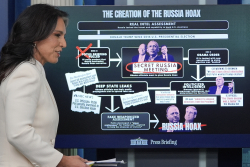Each mission, except the first, has lasted over 400 days, meaning this one could extend into the fall of 2026.
The US Space Force’s space plane will return to orbit in August, according to a July 28 announcement. Officially designated the X-37B Orbital Test Vehicle (OTV-8), the unmanned craft will launch on a SpaceX Falcon 9 rocket from Kennedy Space Center to test laser communications and quantum navigation technology, among other unpublicized tasks. The Air Force Rapid Capabilities Office and the Pentagon’s Defense Innovation Unit (DIU) are also involved with the mission.
This eighth X-37B mission comes less than six months from the conclusion of the seventh, after the program was almost cancelled in 2020. Each mission, except the first, has lasted over 400 days, meaning this one could extend into the fall of 2026.
Laser Communications Tests
The Space Force said the mission will test laser communications technology using proliferated commercial satellite networks in low-Earth orbit (LEO). SpaceX’s laser communication terminal-equipped Starlink satellites will likely be involved, though the announcement did not specify.
Laser systems are more efficient since their shorter wavelengths can transfer more data faster than traditional radio communications. They also require less power and smaller equipment. Furthermore, laser beams’ targeted nature makes them far more secure. The Space Force announcement said that using proliferated relay networks enhances the US space architectures’ resilience by eliminating single points of failure.
Laser communications, however, are not without their complications. LEO satellites travel at 17,000 miles per hour, offering only a small window for lasers to find the correct terminals, transmit their data, and maintain the connection long enough for data transference. Mechanical vibrations and atmospheric conditions can also affect laser beams, detracting from their reliability.
These tests will likely address concerns over the Space Force’s Space Development Agency’s planned LEO satellite constellation. That project will rely on laser communications, but the Government Accountability Office has criticized the agency’s plan to purchase hundreds of such satellites before the laser technology is fully tested and approved.
Quantum Navigation
The Global Positioning System (GPS) is becoming more vulnerable to interference, raising questions about the US military’s GPS reliance. GPS drives countless systems, from ships and aircraft to orbital vehicles and missiles. Iran has shown the ability to disrupt GPS around the Strait of Hormuz, and potential peer and near-peer adversaries like China and Russia are undoubtedly far more capable. GPS denial is common in the Ukraine war.
The Pentagon is aware of this situation. DIU Portfolio director Lt. Colonel Nicholas Estep said that “You really must presume a denied and degraded environment in which you cannot rely on external PNT (Precision, Navigation, and Timing) signals like GPS.” The DIU’s project seeks localized alternatives that are not susceptible to signal jamming or spoofing on the battlefield, in flight, or in space.
Transition of Quantum Sensors (TQS) pinpoint locations by measuring the difference between subatomic particles, which is made possible by minute variances in the Earth’s magnetic and gravitational fields. These variances have been mapped out. The Australian company Q-CTRL is testing a similar system based on gravity maps. This X-37B mission will test orbital navigation by detecting the rotation and acceleration of atoms without using GPS.
As with any new technology, however, challenges exist. TQS systems are extremely sensitive, and achieving performance outside of a laboratory is very difficult. Robust systems that can survive in a contested environment are yet to be fielded. But the effort must be made, since a successful system would be all but impossible to disrupt, since it would not rely on external signals.
Congress awarded $1 billion to the X-37B program in the recently passed reconciliation package.
About the Author: William Lawson
William Lawson is a military historian focusing on World War II and 20th century conflicts and the American Civil War. His specialty is operational level warfare, especially American amphibious doctrine. He writes on history, politics, and firearms for multiple publications and historical journals. He serves on the editorial advisory board for the Saber & Scroll Journal and Military History Chronicles and is a member of the Society for Military History and the American Historical Association. Lawson is based in Virginia.
Image: DVIDS.


















